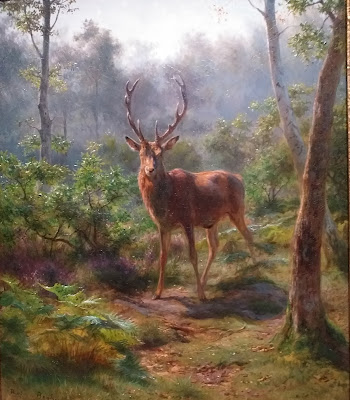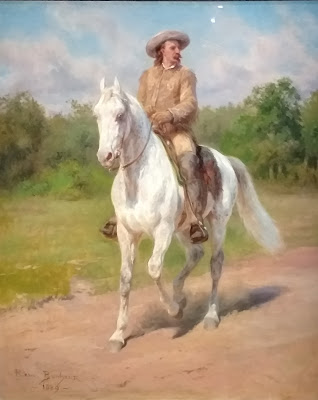 |
| Portrait of Rosa Bonheur (detail) 1898 by Anna Klumpke(1856-1942) |
Rosa Bonheur is a rare example of a woman painter independent and successful enough to live by her own earnings in 19th Century France. She was so commercially successful, especially in the U.S. and Britain, that by the age of 38 she had bought herself a château on the edge of Fontainebleau forest and moved into it with her life-long devoted friend Nathalie Micas and Nathalie's mother, who supervised the practical side of living. Their domaine was baptised "Domaine de la parfaite amitié" (Domain of perfect friendship)
 |
Rosa Bonheur and Nathalie Micas Le Marché aux Chevaux (the Horse Fair) 1855
|
The painting which made a star of Rosa Bonheur in 1855 was "The Horse Fair". It is now in the New York Met, and is too big to be moved, but the exhibition at the Musée d'Orsay has a smaller version sent by the National Gallery, London. This smaller picture was made to allow engravings to be made in order to publicise the work. A full-scale sketch is also on display, which was only recently found in the attic of the château!
 |
| Deux Lapins (2 Rabbits) 1840 |
The portrait of two rabbits is kept in Bordeaux, Rosa's town of birth. This was one of her first works exhibited at the annual 'Salon'.
Rosa's father, a painter, had educated his family in the skills of drawing and painting. His own endearing portrait of her as a little girl figures in the exhibition:
 |
Raymond Bonheur (1796-1849) Rosa Bonheur as a child
|
Marie-Rosalie Bonheur, to give the artist her full name, was 4 years old in this picture. She is clutching a marionette and a pencil. The 'A' she has just drawn was part of an 'ABC' book she made, illustrating each letter with an animal.
 |
| Auguste Bonheur: Portrait of Rosa Bonheur 1848 |
Here is a portrait of the artist by her brother Auguste. For the first and last time, the Salon exhibition of 1848 showed works by 4 members of the Bonheur family, including their father. This was the year that Rosa, aged only 26, earned a 1st class medal, quite an achievement in a male-dominated world.
There are no self portraits. Rosa, the name she adopted later, in memory of the pet name her mother called her, was not primarily interested in portraying herself or other people, but she had a special affinity with animals.
 |
| Le Labourage (Ploughing) 1844 (private collection) |
The above work got her noticed and appreciated by the establishment and led to a commission for a magnificent work which lives in the Musée d'Orsay:
 |
| Labourage nivernais (Ploughing in the Nivernais) 1849 |
Rosa Bonheur spent a year executing studies and perfecting this very large work to be ready for the 'Salon' of 1849. Her style is realistic, meticulous. She depended on much careful observation and sketching.
She has an empathy for the beasts she portrays. Viewers are fascinated by the ox in the centre, who appears to be being prodded by the man and is staring out at us perhaps in an incriminating way. The emphasis is on the beasts, not the men. The work is hard; the oxen are straining to pull the plough up the slope.
 |
El Cid, lion's head 1879
|
Rosa endows her lion portrait with strength and courage, or she perceives those qualities in his gaze. This was the work that was donated by her main dealer, Ernest Gambart, to the Prado Museum, and for which she was later awarded a Spanish medal.
A majestic lion portrait has been lent by king Charles III of Britain:
 |
| Tête de Lion (Lion's head) 1870/91 |
Rosa surrounded herself with animals- "a true menagerie", as she said, as many as 200, including a family of lions. The land she had purchased near Fontainebleau allowed them all to be housed comfortably. She would sit outside reading her newspaper in the presence of deer, for example, and surreptitiously study their movements.
 |
| Un Cerf (A Stag) 1893 |
Rosa composed natural looking scenes of Fontainebleau forest, based on her many sketches and watercolours.
 |
| Le Gros Chêne (The Big Oaktree) watercolour |
All her animals have a personality, not least her domestic ones. Among several dogs, there were her pet Yorkshire terriers Charley and Daisy:
 |
| Toutou, le bien-aimé ( Well-beloved doggie) 1885 |
Rosa Bonheur was an accomplished animal sculptress. Like many artists, she used her clay and wax models to help her with her paintings. However she preferred to leave the career of sculptor to her younger brother Isidore. This is one of her works, lent by the Bordeaux Fine Arts Museum:
 |
| Taureau beuglant (Bull lowing) 1847 bronze |
Perhaps the most famous event to publicise Rosa was her meeting with Buffalo Bill.
He was visiting the 1889 World Fair in Paris, along with a group of native Americans and their horses. Rosa admired how the "Indians" communicated with their animals and deplored their fate. Naturally she did a portrait of Buffalo Bill, of which it is said he was very proud:
 |
| Colonel William F. Cody 1889 |
This painting has been lent courtesy of the Buffalo Bill Center of the West, U.S. What a pity for Rosa that she never got to the wild west and the great prairies she loved to read about in James Fenimore Cooper's novels! Rosa had a great admiration for America with its egalitarian treatment of women. Her last companion and biographer was Anna Klumpke, who had come from her native San Francisco to study art in Paris. The two women were pleasantly surprised to see the flags of both their nations attached to the summit of Rosa's new workshop by the workmen in 1899.
 |
Le Berger des Highlands (The Highlands Shepherd) 1859
|
Although she never made it to the States, Rosa Bonheur had a wonderful time travelling in Scotland, visiting some of the places where Walter Scott set his novels. She even bought some Scottish Blackface sheep to bring back home, but couldn't get them past the customs.
 |
| Tête de Chien (Head of dog) 1869 charcoal, pastel and chalk |
Rosa Bonheur (1822-1899) from 18th October 2022 to 15th January 2023 at the Musée d'Orsay,
1 rue de la Légion d'honneur, Paris 75007.
******************

















Comments
Post a Comment